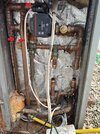Had a few issues with our central heating system. A valve was getting stuck on, and the pump was getting increasingly noisy. It finally packed in and we lost hot water.
Simple job, I figured - replace the pump, might as well replace the valves while I'm at it. Had a load of trouble though. The valves were counterfeit (that'll show me buying from Amazon because it was cheaper...) but only realised after fitting.
My issue was, it just wouldn't circulate. The valves in manual override, and the pump pumping (making very slight vibrations at least). There was definitely water at the pump, as undoing the nut slightly caused a small leak.
But the boiler heated the water in it's immediate circuit - then it just stopped on the input side of the pump. I could feel the hot water on the left, and it was still cold on the right. The boiler turned off as no water was circulating for it to heat.
The valves for hot water and heating were manually set to open - so it's not any wiring issue. I tore the valves out (found out they were knockoffs) and checked and they DO open properly when set to manual - so can't have been that.
The pump valves were open, at least I checked them and set them to fully open before fitting. The pump is happily reporting no blockages.
Just... nothing is happening. I'm all out of ideas on what to check. My only thought is the brand new pump is defective... I can't see any other reason water wouldn't be flowing.
The hot water inlet didn't drain, so maybe it has a blockage or something in the pipework? But the heating drained fine - so I'd expect at least that to circulate.
Here's the pump/valve layout, after having removed and tested the valves (heating left, hot water right):

I'm curious if anyone knows what the third pipe from the pump outlet is - it has some kind of valve on it, with a twist head, that I haven't touched. But I'm curious what it is - some kind of thermostatic bypass?
Simple job, I figured - replace the pump, might as well replace the valves while I'm at it. Had a load of trouble though. The valves were counterfeit (that'll show me buying from Amazon because it was cheaper...) but only realised after fitting.
My issue was, it just wouldn't circulate. The valves in manual override, and the pump pumping (making very slight vibrations at least). There was definitely water at the pump, as undoing the nut slightly caused a small leak.
But the boiler heated the water in it's immediate circuit - then it just stopped on the input side of the pump. I could feel the hot water on the left, and it was still cold on the right. The boiler turned off as no water was circulating for it to heat.
The valves for hot water and heating were manually set to open - so it's not any wiring issue. I tore the valves out (found out they were knockoffs) and checked and they DO open properly when set to manual - so can't have been that.
The pump valves were open, at least I checked them and set them to fully open before fitting. The pump is happily reporting no blockages.
Just... nothing is happening. I'm all out of ideas on what to check. My only thought is the brand new pump is defective... I can't see any other reason water wouldn't be flowing.
The hot water inlet didn't drain, so maybe it has a blockage or something in the pipework? But the heating drained fine - so I'd expect at least that to circulate.
Here's the pump/valve layout, after having removed and tested the valves (heating left, hot water right):
I'm curious if anyone knows what the third pipe from the pump outlet is - it has some kind of valve on it, with a twist head, that I haven't touched. But I'm curious what it is - some kind of thermostatic bypass?




